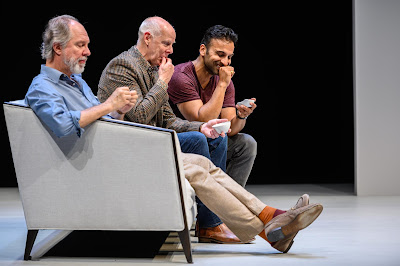The Shaw
Festival has staged its own version of Edmond Rostand’s legendary Cyrano
de Bergerac. Playwright Kate Hennig was commissioned to translate and
adapt the verbally sparkling, ironic and seriously romantic play. She has delivered
a prose translation to be performed by fourteen actors, seven men and seven
women. Seven of the actors are assigned individual roles while the other seven must
handle as many as five roles. That does not create many issues because most of
the secondary characters do not present a problem.
The balcony
scene and the recognition scene at the end of the play are the best and most
memorable parts of the play and I dare say the raison d’etre of its popularity.
There are several other decent scenes but the swashbuckling and the battle scenes,
for example, leave me less than thrilled.
Deborah Hay as Roxane and Tom Rooney as Cyrano in Cyrano de Bergerac.
Photo by Emily Cooper.
The central
character is of course Cyrano played by Tom Rooney. He is a man of many talents
from a great and brave swordsman, to a poet, an idealist and a fighter against
hypocrisy. Unfortunately, he is ugly and lives in great fear of being mocked.
He loves deeply but is afraid to approach a woman. Even his mother did not love
him. He does fall in love with his cousin, the beautiful Roxane, but she is in
love with the handsome cadet Christian (Jeff Irving).
Roxane, played
by Deborah Hay, is a woman of beauty with a taste for poetry and a desire for romance.
She falls in love with Christian’s beauty, but she expects much more from him.
She finds the higher virtues that Christian cannot express orally in the
balcony scene and in “his” letters and poetry. These reach their apogee in the
balcony scene where Cyrano speaks the poetry of love pretending as to be
Christian. The ruse continues when Cyrano writes letters to Roxane from the war
front all the time pretending that they are from
Christian.
I found the
balcony scene disappointing. Cyrano’s wooing of Roxane as if he were Christian begins
haltingly and picks up speed like a force of nature. He first wants to bring
down the stars from the sky and beat Cupid at
his own game. There is a build-up of passion that reaches an emotional paroxysm
in both Cyrano and Roxane. She trembles, weeps, is drunk with love and declares
herself his. In that climactic moment, Cyrano declares that he is ready to die.
The penultimate
scene where Cyrano reads “Christian’s” last letter to Roxane and she realizes
that it was he who loved her is moving
Rooney and Hay
fell short of reaching that emotional Everest. They are good but I think the
scenes demand more than they delivered. Cyrano’s
death when he utters his last word “panache” evoked some laughter from the
audience. Good grief!
Hay and Rooney
are no doubt capable of expressing great emotional ranges and I am not sure why
director Chris Abraham chose to understate the depths felt by the characters in
these scenes.
Irving as the
handsome and verbally challenged dolt wins and keeps Roxane on the love and
letters of Cyrano. He is just a prop and perhaps a symbol of the vacuity of
beauty, but we give the actor credit for his representation. The other
characters that are of more than minor importance are the poet Rageneau (Kyle
Blair), the nasty De Guiche (Patrick Galligan) and Le Bret (Tanja Jacobs).
With the
significant exceptions noted, the production is well done. The opening scene
where Montfleury (David Adams) is thrown off the stage and the crowd scenes are
well done. The scene in Rageneau’s bakery between Cyrano and Roxane is moving.
The boom-boom scene in the Siege of Arras has its moments.
The set design
by Julie Fox is good and efficient for the
locales of the action.
_____________
Cyrano de Bergerac by Edmond Rostand in an adaptation by
Kate Hennig will run in repertory until October 20, 2019 at the Royal George
Theatre, Niagara-on-the-Lake,
Ontario. www.shawfest.com.
James Karas is the Senior Editor - Culture of The Greek Press. www.greekpress.ca




















